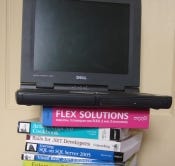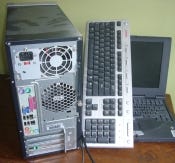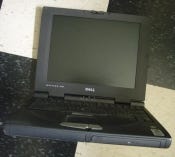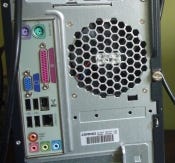5 Things To Do With Dead PC Hardware
Learn the five best fates for dead PCs, notebooks, hard drives, and other gear. Hint: Letting them go to a landfill is not one of them. Recycling is.

| |
| |
Sooner or later, the PC I'm typing this on is bound to drop dead. One day I'll walk in here, push the power button, and hear a scrape and a clunk that tells me my hard drive is out of commission. Or, worse, I'll get nothing at all. Failing that, it's going to end up dying a different kind of death, although one that's every bit as ignominious -- it'll be yanked out and replaced with something a little more cutting-edge, because time and technology have moved on.
Whatever my PC's exact fate, there's one thing I know won't happen: This machine will not sit at the curbside and wait to be heaved into a garbage truck. In this piece I'll talk about four possible fates for dead hardware. "Dumped into a landfill" is not one of them. That's a fate worth working to avoid, especially since so many of the electronic goods that come into our hands can still be reclaimed, no matter what they're like when we're done with them.
What's A "Dead" PC?
Let's start with a definition or three. The most common definition of "dead" is "I can't use this thing anymore." Sometimes dead means too slow or clunky for your chosen use; time and utility have passed it by.
That Pentium III 650 that used to run Windows 2000 but barely boots anymore, the range of software (and hardware) it can support has narrowed drastically? It might be useful to someone who has fewer expectations from their PC, but to you, it's dead.
Sometimes dead means you've simply outgrown what you have. The system runs fine, but you've moved on to bigger and better things. For example: my 1GB single-core Centrino notebook, which I replaced with a 4GB dual-core 64-bit model -- one which, irony of ironies, cost less than half what I paid for the previous one; such is the march of technology. (Keep reading to find out the fate of the old machine.)
And sometimes dead is just dead. Billy Crystal's character Miracle Max in The Princess Bride put it best: "There's a big difference between mostly dead and all dead. Mostly dead is slightly alive." In other words, even a machine that doesn't boot or power on may still be good for something -- even if it's something you can't think of.
| |
| |
1. Revival
Let's start with hardware that hasn't died, but has outlived its current use. Rather than deep-sixing it completely, perhaps it's worth putting that device to use in another context. The most common version of this is to give the hardware in question to another family member or a friend. Usually you'll do this after cleaning it up and making sure it's a) marginally functional and b) not likely to break in a way that will stump its new owner.
Cleaning up and resetting an existing system for re-use has gotten a lot easier in recent years, thanks to most systems shipping with either a restore / recovery partition, a set of recovery disks, or both. Sometimes the former are used to build the latter, when you first uncrate the machine.
That said, unless you're about as organized as my mom or as big a packrat as my dad, the odds of those tools surviving any number of office straighten-ups, household spring cleanings, and I-think-I-threw-out-the-wrong-thing shocks goes way down with time.
If you don't have the disks or the recovery partition anymore, call the PC manufacturer (they're still around, one hopes) and ask them for a recovery CD/DVD. They should be able to sell you one if you have the original OS license key sticker. Note that if you bought your system as a "whitebox" from a local, independent reseller, they probably gave you the CD. Lose that and you're generally out of luck.
Even if you haven't lost the original OS, you might do well to install a new one --Linux or Windows, depending on what's within your budget and what seems to work best. Bear in mind that Linux is no longer a one-size-fits-all proposition and hasn't been for some time; you want a variety of Linux distros that will complement your hardware well.
Linux Installation Guidelines
1-2 Years Old / Multi-Core: Any of the recent, big-name Linux distributions will do fine -- e.g., Ubuntu, Fedora, OpenSUSE, CentOS, etc.
2-3 Years Old / Single-Core: Generally the same as the above, but if performance turns out to be an issue, you can go with a scaled-down build designed for economy of space and speed. Xubuntu is the most common example.
Anything Older: Go with a distribution built to be minimal. Puppy Linux is a good one, but the still-in-progress Moblin is worth a look even at this stage of its development.
2. Repurposing
Another option with an older machine is to set it up as a file / print / media server -- a way to offload duties that you don't want to foist upon your existing PC. Since a file server generally doesn't need to be the fastest machine in the world as far as user interaction goes -- it just needs to have a decent network pipe -- you can get away with surprisingly minimal hardware to make this work. For my own file/print setup I used a four-year-old notebook with a USB-attached hard drive in an external cage (a 320GB drive from another machine, which I'd replaced with a 1TB drive). Streamed HD video is probably out of the question, but MP3s and print jobs all work fine.
| |
| |
3. Cannibalization
This means, of course, salvaging what pieces you can and using them elsewhere. Your average "dead" PC has at least two or three parts which by themselves are probably fine. They can generally be cycled over into another PC without trouble, especially if you're buying a new machine and want to save a few dollars here and there. Still, as with anything else, caveats apply.
Peripherals Keyboards, mice, headsets, USB hubs, removable-storage bays (such as those used for memory cards), and so on are the most common things that can be cycled over are.
If they're still in good shape, there's no reason to dump them as long as they still do what you need and will work with future hardware. One exception is PS/2-connected mice or keyboards, which can be connected to USB-only machines but only through specially-designed connectors. If you're hanging onto an older PS/2 keyboard for dear life (some people get very attached to their hardware -- me included!), the cost of an input dongle is negligible.
Hard Drives Any type of storage device is well worth keeping and re-using. Obviously anything with sensitive data on it needs to be wiped down first; see Darik's Boot and Nuke, for more on how to do this easily.
TIP: Always use new cabling, both data and power, when moving an old device. The cables you used with the hardware in its original setup may have developed crimps or bends that turn into full-blown shorts when moved into another machine. I've had this happen to me more than a few times; a hard drive that was working fine in one machine was "dead" in another—actually, just mostly dead, since all it took was a new SATA cable to bring it back to life.
Memory Modules These can usually move between machines that support them with little difficulty. There are two caveats here, though:
You might not always be getting the best possible performance on the target system.
Two, you may run into finicky behaviors you didn't see before. Systems that use server memory -- i.e., registered or ECC memory -- are a lot fussier with memory than regular machines.
The last computer I had in this regard refused to work reliably with two separate sets of DIMMs and finally only worked with a Compaq-branded set.
Video Cards These are worth pulling and saving, since what's old or outdated for one user is more than cutting-edge for another -- provided, of course, it's the right bus type. Also bear in mind that video cards can be a source of unexpected power consumption, something I discovered and wrote about here


If it looks like it's been through a war, it probably has been.
Notebooks are tougher to cannibalize, since they tend to be all of a piece. About the only things that can be reliably reused are power supplies (best used in either the same variety of notebook or one with the same wattage requirements) and hard drives.
Sometimes it's not possible to know whether or not these things have happened, although there are giveaways: musty odors, encrustations of dust or dirt on the fan or air intakes, etc. Rule of thumb: if it looks (or smells) like it's been through a war, it probably has been.
The best place to start -- if you have working hardware in good condition -- is the Cristina Foundation, dedicated to putting computers into the hands of "people with disabilities, students at risk and economically disadvantaged persons". They may take in hardware that can be repaired and put to use, but you're best off making sure whatever they get is in decent working order (if not always cutting-edge).
Other groups have similar demands but different aims:
Computers with Causes prefers functional hardware whenever possible.
For a massive rundown of just about every charitable group out there looking for PC hardware, check out the TechSoup site, which you can search based on needs and location.
No discussion of donations and reuse would be complete without some mention of both Freecycle and Craigslist. Craigslist we all know about, but Freecycle is less well-known; it's an aggregate of local groups, each dedicated to providing a place for people to provide things for re-use; computer hardware is just one thing they cover.
Subscribe to a local Freecycle mailing list and pay close attention to the rules about posting and soliciting, as the etiquette on these lists is crucial to getting good results. The disadvantage of both Freecycle and Craigslist is that you typically know very little about the pedigree of the people at the other end of the transaction. 5. Recycling
An old superstition goes, "Never throw away a key!" Never throw out a computer, either. There are better things to do with all that metal, copper, plastic and lead than put it into a landfill. If there doesn't seem to be any other fate left than the trash for a piece of hardware, by all means dispose of it -- but do it the right way.
Many major electronics retailers now offer programs above and beyond the usual recycling of cellphones, used CFLs, or dead batteries. Best Buy (http://www.bbycommunications.com/crnew/recycling.asp) does this routinely for appliances and TVs, and furniture-retailer IKEA regularly hosts e-cycling events albeit only in California at the moment. Many Staples outlets now also accept computer parts for recycling, albeit for a fee of $10 per system (peripherals can be thrown in for free).
On a more upscale, professional level, IBM has its own IT buyback program, and east-coast based data-erasure experts Guardian Data Destruction also offers e-cycling as an adjunct to its more conventional drive-wiping and document-shredding services. Network Liquidators is an outfit that deal specifically with used telecom and networking hardware, a lot of which can be resold fairly easily since it tends to be in strong demand, even if it's not up-to-the-second new.
A fairly comprehensive and regularly-updated list of recycling programs by U.S. region is maintained by the Telecommunications Industry Association at EIAE.org. The EPA's resource page is here. And Earth 911 also maintains similar lists, and supplies detailed information about who takes what.
Whichever one you pick, be sure the recycler can show documented proof of compliance with the EPA's R2 practices ,which minimizes the chance they're dumping waste on the sly or shipping it overseas.
InformationWeek has published an in-depth report on Windows 7. Download the report here (registration required).
About the Author(s)
You May Also Like












